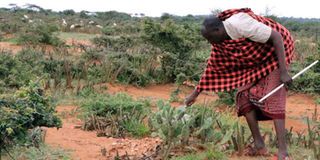Why cactus is a thorn in the flesh of Laikipia villagers

Mr Peter Mashami of Naibunga Community Conservancy in Laikipia County points at the cochineal insect which feeds exclusively on the cactus species. The insect sucks water from the plant’s succulent parts, leaving it to decay. PHOTO | BONIFACE THUKU | NATION MEDIA GROUP
What you need to know:
The plant, which locals say was introduced by the colonial farmers as an ornamental plant, has now colonised much of their land,
It is the second biggest elephant killer in the north after poaching and it thrives in the dry seasons.
The community has lost about 500 goats in the last one year and others have been left toothless after feeding on the plant.
In a parched swathe of land in a corner of Laikipia County, the Samburu are caught up in an epic battle with the cactus that is laying waste to thousands of acres of these rangelands.
The plant, which locals say was introduced by the colonial farmers as an ornamental plant, has now colonised much of their land, and has become a major thorn in their flesh.
To them the cactus is a killer. It has brought misery to the Naibunga Community Conservancy in Laikipia North as it also kills their livestock - their source of livelihood. Elephants, too, have not been spared.
ELEPHANT KILLER
In fact, it is the second biggest elephant killer in the north after poaching and it thrives in the dry seasons.
The conservancy's chairman, Mr Masambai Ole Metiaki, said the ruthless plant has claimed huge chunks of land of the pastoralists grazing land.
The community has lost about 500 goats in the last one year and others have been left toothless after feeding on the plant.
“It has taken all our land since it started growing here. We have lost livestock to this menace,” he says.
Mr Peter Mashami, explains how the plant hits them locals that livestock and wild herbivores like the elephant are lured to the plant by its seemingly juicy pods.
However as the animals munch away on the pods, the poisonous thorns prick or get stuck between their teeth causing them to rot. With time the teeth fall off and the animals cannot feed. They simply waste away and die.
COCHINEAL INSECT
However, there is now light in the horizon, thanks to a small cochineal insect (Dactylopius coccus) that is proving to be a match for the cactus.
The cochineal feeds exclusively on the plant, sucking the water in its succulent parts causing the plant to wilt and decay.
The community is now breeding the insects in greenhouses.
So far nine greenhouses have been set up in different community ranches within Naibunga Conservancy.
“Although it might take time to eradicate the plant, we are happy for the gradual change which is taking place now. “The insect is feeding on the plant and from where we have done experiment it is a successful idea “ says Mr Joseph Putunoi of the Northern Rangelands Trust.





